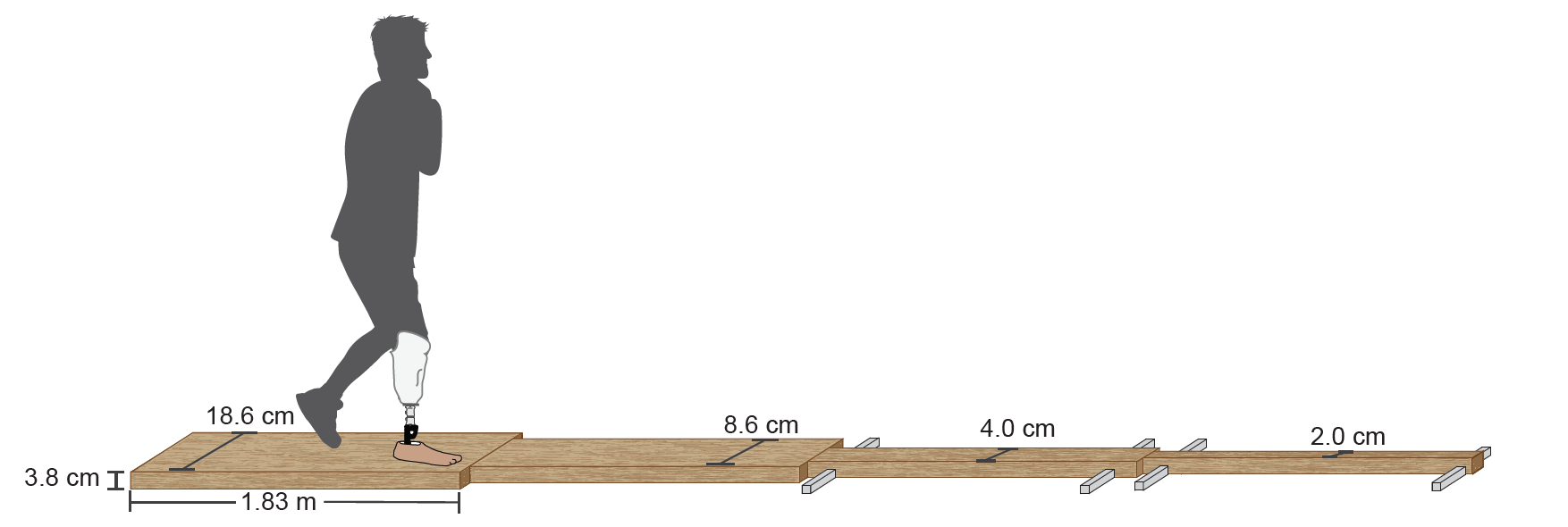


Posted April 6, 2021
Andrew Sawers, Ph.D., C.P.O., University of Illinois at Chicago
Brian Hafner, Ph.D., University of Washington

Dr. Andrew Sawers
The number of individuals living with lower limb amputation is steadily increasing, and scientists estimate that by 2050 there will be over 2.3 million people living with lower limb amputation in the U.S.1 The incidence of lower limb amputations in Veterans using Veterans Health Administration Services increased just over 1.4% between 2008 and 2018.2 With a growing population of prosthetics users, there is also a growing population of individuals at risk of falling. Over half of lower limb prosthesis users report falling, an event that can lead to additional injury and loss of mobility, within the past year. While several clinical balance tests are currently in use, they fail to progressively challenge balance, leading to ceiling effects that can limit their ability to identify lower limb prosthesis users at an increased risk of falling. In addition, there currently are few psychometric properties to guide selection, administration, and interpretation of clinical balance tests among lower limb prosthesis users. With the help of a fiscal year 2016 Orthotics and Prosthetics Outcomes Research Program (OPORP) Award, Dr. Andrew Sawers and his co-investigator, Dr. Brian Hafner, evaluated the psychometric properties of a novel Narrow Beam Walking Test (NBWT) for assessing fall risk in lower limb prosthesis users.
Dr. Sawers hypothesized that existing clinical balance tests were not sufficiently challenging to accurately discriminate between fallers and non-fallers. To test this hypothesis, his team designed the NBWT (Figure 1), which consists of four low beams, each narrower than the previous, in order to provide a progressively increasing challenge to balance control. To assess the validity of the NBWT, Dr. Sawers and his team compared the NBWT to existing clinical balance tests, including the Berg Balance Scale (BBS), Timed Up and Go (TUG), Activities-specific Balance Confidence Scale (ABC), Four Square Step Test (FSST), and the 10 Meter Walk Test (10mWT). His team also aimed to evaluate the reliability of the NBWT, TUG, FSST, and 10mWT. To accomplish this, the research team performed initial balance assessments on a sample of lower limb prosthesis users using the FSST, TUG, BBS, ABC, 10mWT and the NBWT. Characterization measures, including fall history, were also recorded at baseline. Participants were then retested 3-7 days later.

Figure 1. Narrowing Beam Walking Test. Participants walk along four progressively narrower beam segments with their arms crossed over their chest. If participants move their arms or step off the beam the trial is ended, and the distance walked to that point is recorded. Height of each segment is 3.8 cm.
Based on a preliminary evaluation and comparison of the FSST, TUG, BBS, ABC, and NBWT, Dr. Sawers’ team proposed cutoff scores to discriminate fallers from non-fallers. The team also derived associated validity indices for each set of cutoff scores to enable clinicians to estimate the probability that a lower limb prosthesis user will fall within the next 12 months. The proposed validity indices provide a vast improvement over standard of care by assigning a probability of falling to an individual LLP user rather than a simple faller or non-faller designation. Dr. Sawers also published reliability indices for the NBWT, TUG, FSST, and 10mWT. The reliability indices enable clinicians to 1) select appropriate balance tests for making clinical decisions at the group or individual level; 2) interpret the standard error of measurement of individual test scores; and 3) evaluate change in balance over time for lower limb prosthesis users. While the researchers found that all of the balance tests evaluated were reliable for group-level comparisons, the FSST, 10mWT, and NBWT were the only tests suitable for individual-level evaluations in established unilateral lower limb prosthesis users. In performing this research, Dr. Sawers found that failure to accommodate practice effects (i.e., individual improvement through repeated attempts) could significantly reduce the diagnostic accuracy of the NBWT. The team observed practice effects in 45%-76% of participants performing the FSST, TUG, and 10mWT, suggesting that practice effects also affect the accuracy of these and potentially other performance-based clinical tests and limit their use for making clinical decisions. However, unlike many other clinical balance tests, the NBWT’s administrative and scoring procedures were designed to accommodate practice effects. The NBWT may therefore be a better tool for guiding clinical decisions for individual lower limb prosthesis users.
In addition, Dr. Sawers’ team developed and tested a fall-type classification framework. The team used the framework to classify fall patterns reported by 66 lower limb prosthesis users to better understand the circumstances surrounding falls. While falls can result from a number of factors (e.g., prosthetics failures, collisions, weight shifts), lower limb prosthesis users most commonly experienced falls while walking (62%), on level terrain (46%), due to trips (26%), slips (22%), and prosthetic related issues (22%). Dr. Sawers’ team received follow-on funding to develop a structured, clinically-meaningful, and lower limb prosthesis user-specific fall circumstance and consequence survey based on the fall-type classification framework. Other research groups are now adopting and implementing this framework.
Drs. Sawers’ and Hafner’s research to-date demonstrates that the NBWT discriminates fallers and non-fallers with greater accuracy than existing clinical balance tests. They also worked to improve the NBWT design to increase portability and durability and developed a detailed fabrication guide to make the NBWT more accessible. As a result, clinical, industry, and academic centers across the U.S., including several Veterans Administration Health Care Systems, are now using the NBWT. Dr. Sawers’ team has been extremely productive, having published three articles in Physical Medicine and Rehabilitation, one article in Prosthetics and Orthotics International, and one article in Physical Therapy, with another four manuscripts underway. A “How-To” video series on the NBWT as well as a webinar on classifying falls in lower limb prosthesis users were also produced and are available online.
Dr. Sawers and Dr. Hafner received follow-on funding from the Orthotics and Prosthetics Outcomes Research Program to address the need for self-report fall outcomes measures. Their work will help clinicians identify lower limb prosthesis users at greater risk of falling, and thereby help reduce future fall-related injuries.
Publications and other Research Outcomes:
Sawers A and Hafner BJ. 2019. Conventional administration and scoring procedures suppress the diagnostic accuracy of a performance-based test designed to assess balance ability in lower limb prosthesis users. Prosthetics and Orthotics International 43(4):402-408.
Kim J, Hafner BJ, Major M, and Sawers A. 2019. Frequency and circumstances of falls reported by ambulatory unilateral lower limb prosthesis users: A secondary analysis. Physical Medicine and Rehabilitation 11(4):344-353.
Sawers A and Hafner BJ. 2020. Using clinical balance tests to assess fall risk in established lower limb prosthesis users: Cutoff scores and related validity indices. Physical Medicine and Rehabilitation 12(1):16-25.
Sawers A, Kim J, Balkman GS, and Hafner BJ. 2020. Inter-rater and test-retest reliability of performance-based clinical balance tests administered to established unilateral lower limb prosthesis users. Physical Therapy 100(7):1206-1216.
Sawers A and Hafner BJ. 2020. Characterizing practice effects in performance-based tests administered to unilateral lower limb prosthesis users: A preliminary study. Physical Medicine and Rehabilitation (online ahead of print).
Walker N, Hafner BH, Sawers A. The American Academy of Orthotists and Prosthetists “How-To” Video Series. The Narrowing Beam Walking Test (NBWT). https://www.oandp.org/page/HowToVideos
Kim J, Hafner BH, Sawers A. (2019). The American Academy of Orthotists and Prosthetists Outcomes Research Committee Online Webinar. Classifying falls in patients that use lower limb prosthesis. http://olc.oandp.org/diweb/catalog/item/id/4978305/
References:
- Zeigler-Graham K, MacKenzie EJ, Ephraim PL, et al. 2008. Estimating the prevalence of limb loss in the United States: 2005-2050. Archives of Physical Medicine and Rehabilitation 89(3):422-429. Doi: 10.1016/j.apmr.2007.11.005.
- Cai M, Xie Y, Bowe B, et al. 2021. Temporal trends in incidence rates of lower extremity amputation and associated risk factors among patients using Veterans Health Administration Services from 2008 to 2018. JAMA Network Open 4(1):e2033953. Doi: 10.1001/jamanetworkopen.2020.33963.
Link:
Last updated Friday, December 13, 2024














